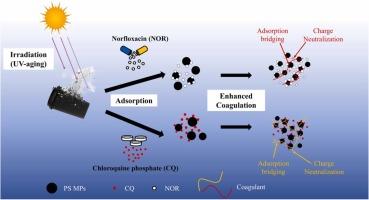紫外光老化聚苯乙烯微塑料的动态过程,同时吸附药物,随后一起凝固去除
IF 11.3
1区 环境科学与生态学
Q1 ENGINEERING, ENVIRONMENTAL
引用次数: 0
摘要
塑料的老化及其对水中残留污染物的吸附作用越来越受到人们的关注。本研究采用coulter counter半定量分析了聚苯乙烯(PS)微塑料(MPs)的紫外老化动态过程,同时考察了老化聚苯乙烯(PS)微塑料与两种常用药物[诺氟沙星(NOR)和磷酸氯喹(CQ)]的吸附相互作用。经过36.0 h的时效作用后,MPs的粒径呈快速下降趋势,从微米级减小到纳米级,粒子数浓度增加约2 ~ 3倍。在目前测定的MPs尺寸范围内,PS MPs的表观紫外老化过程主要服从准一级动力学模型。老龄MPs的药物摄取与MPs表面含氧基团的含量完全一致,而不是与MPs的大小一致。详细研究了吸附机理,主要包括静电吸引、氢键和π-π电子给体-受体相互作用。由于两种污染物的协同作用,药物吸附的MPs随后通过增强的凝聚有效地去除。本研究为了解MPs的紫外老化过程和同时吸附行为提供了一个全新而全面的视角,并提出了协同去除MPs的策略。本文章由计算机程序翻译,如有差异,请以英文原文为准。

Dynamic process of UV-aging polystyrene microplastics, simultaneous adsorption of drugs, and subsequently coagulative removal together
The aging of plastics and their adsorptive interactions with the residual contaminants in water has attracted increasing attentions. In this study, the dynamic process of UV-aging polystyrene (PS) microplastics (MPs) were semi-quantitatively analyzed using a coulter counter, and the adsorptive interactions between the aged PS MPs and two popular drugs[norfloxacin (NOR) and chloroquine phosphate (CQ)] were investigated simultaneously. The MPs presented a rapid size downtrend, reduced from micrometer to nanometer, and the particle number concentration increased about 2−3 times after a 36.0 h aging effect. The apparent UV-aging process of PS MPs mainly obeyed the pseudo-first order kinetic model in currently measured MPs’ size range. The drug uptakes of the aged MPs were fully consistent with the contents of oxygen-containing groups on MPs surface rather than MPs’ size. The involved adsorption mechanisms were investigated in detail mainly including electrostatic attraction, hydrogen bonding, and π-π electron donor-acceptor interaction. The drug adsorbed MPs were subsequently efficiently removed by an enhanced coagulation together owing to the synergistic effects of the two pollutants. This study provides a novel and comprehensive perspective on the fundamental understanding the UV-aging process of MPs and the simultaneous adsorption behaviors, furthermore, a strategy was proposed for their collaborative removal.
求助全文
通过发布文献求助,成功后即可免费获取论文全文。
去求助
来源期刊

Journal of Hazardous Materials
工程技术-工程:环境
CiteScore
25.40
自引率
5.90%
发文量
3059
审稿时长
58 days
期刊介绍:
The Journal of Hazardous Materials serves as a global platform for promoting cutting-edge research in the field of Environmental Science and Engineering. Our publication features a wide range of articles, including full-length research papers, review articles, and perspectives, with the aim of enhancing our understanding of the dangers and risks associated with various materials concerning public health and the environment. It is important to note that the term "environmental contaminants" refers specifically to substances that pose hazardous effects through contamination, while excluding those that do not have such impacts on the environment or human health. Moreover, we emphasize the distinction between wastes and hazardous materials in order to provide further clarity on the scope of the journal. We have a keen interest in exploring specific compounds and microbial agents that have adverse effects on the environment.
 求助内容:
求助内容: 应助结果提醒方式:
应助结果提醒方式:


